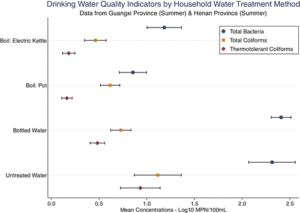Boiled or Bottled: Regional and Seasonal Exposures to Drinking Water Contamination and Household Air Pollution in Rural China
Abstract/Summary: We assessed the regional and seasonal prevalence of HWT practices (including bottled water use) in low-income rural areas in two Chinese provinces, evaluated the microbiological safety of drinking water and associated health outcomes, and estimated the air pollution burden associated with the use of solid fuels for boiling. Methods: We conducted cross-sectional surveys and collected drinking water samples from 1,033 rural households in Guangxi and Henan provinces. Temperature sensors affixed to pots and electric kettles were used to corroborate self-reported boiling frequencies and durations, which were used to model household air pollution (HAP) in terms of estimated particulate matter ≤2.5μm in aerodynamic diameter (PM2.5) concentrations. Results: Based on summer data collection in both provinces, after controlling for covariates, boiling with electric kettles was associated with the largest log reduction in thermotolerant coliforms (TTCs) (0.66log10 TTC most probable number/100mL), followed by boiling with pots (−0.58), and bottled water use (−0.39); all were statistically significant (p<0.001). Boiling with electric kettles was associated with a reduced risk of TTC contamination [risk ratio (RR)=0.25, p<0.001] and reported diarrhea (RR=0.80, p=0.672). TTCs were detected in 51% (n=136) of bottled water samples. For households boiling with biomass, modeled PM2.5 concentrations averaged 79 μg/m3 (standard deviation=21). Discussion: Our findings suggest that where boiling is already common and electricity access is widespread, the promotion of electricity-based boiling may represent a pragmatic stop-gap means of expanding safe water access until centralized, or decentralized, treated drinking water is available; displacing biomass use for water boiling could also reduce HAP concentrations and exposures. Our results also highlight the risks of increasing bottled water use in rural areas, and its potential to displace other sources of safe drinking water, which could in turn hamper efforts in China and other LMICs toward universal and affordable safe water access.
Boiled or Bottled: Regional and Seasonal Exposures to Drinking Water Contamination and Household Air Pollution in Rural China
Authors: Cohen, A., Pillarisetti, A., Luo, Q., Zhang, Q., Li, H., Zhong, G., Zhu, G., Colford, J. M., Smith, K. R., Ray, I., & Tao, Y.
Publication Year: 2020 | Journal / Publisher: Environmental Health Perspectives
Abstract/Summary: We assessed the regional and seasonal prevalence of HWT practices (including bottled water use) in low-income rural areas in two Chinese provinces, evaluated the microbiological safety of drinking water and associated health outcomes, and estimated the air pollution burden associated with the use of solid fuels for boiling. Methods: We conducted cross-sectional surveys and collected drinking water samples from 1,033 rural households in Guangxi and Henan provinces. Temperature sensors affixed to pots and electric kettles were used to corroborate self-reported boiling frequencies and durations, which were used to model household air pollution (HAP) in terms of estimated particulate matter ≤2.5μm in aerodynamic diameter (PM2.5) concentrations. Results: Based on summer data collection in both provinces, after controlling for covariates, boiling with electric kettles was associated with the largest log reduction in thermotolerant coliforms (TTCs) (0.66log10 TTC most probable number/100mL), followed by boiling with pots (−0.58), and bottled water use (−0.39); all were statistically significant (p<0.001). Boiling with electric kettles was associated with a reduced risk of TTC contamination [risk ratio (RR)=0.25, p<0.001] and reported diarrhea (RR=0.80, p=0.672). TTCs were detected in 51% (n=136) of bottled water samples. For households boiling with biomass, modeled PM2.5 concentrations averaged 79 μg/m3 (standard deviation=21). Discussion: Our findings suggest that where boiling is already common and electricity access is widespread, the promotion of electricity-based boiling may represent a pragmatic stop-gap means of expanding safe water access until centralized, or decentralized, treated drinking water is available; displacing biomass use for water boiling could also reduce HAP concentrations and exposures. Our results also highlight the risks of increasing bottled water use in rural areas, and its potential to displace other sources of safe drinking water, which could in turn hamper efforts in China and other LMICs toward universal and affordable safe water access.
PDF on Publisher Website | PDF on OSF

